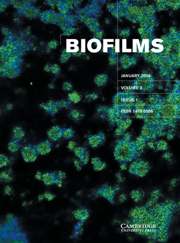Crossref Citations
This article has been cited by the following publications. This list is generated based on data provided by
Crossref.
McLandsborough, L.
Rodriguez, A.
Pérez-Conesa, D.
and
Weiss, J.
2006.
Biofilms: At the Interface between Biophysics and Microbiology.
Food Biophysics,
Vol. 1,
Issue. 2,
p.
94.
Tresse, O.
Lebret, V.
Benezech, T.
and
Faille, C.
2006.
Comparative evaluation of adhesion, surface properties, and surface protein composition of Listeria monocytogenes strains after cultivation at constant pH of 5 and 7.
Journal of Applied Microbiology,
Vol. 101,
Issue. 1,
p.
53.
Manuzon, Michele Y.
and
Wang, Hua H.
2006.
Biofilms in the Food Environment.
p.
105.
Teixeira, Paula C.
Leite, Gonçalo M.
Domingues, Ricardo J.
Silva, Joana
Gibbs, Paul A.
and
Ferreira, João Paulo
2007.
Antimicrobial effects of a microemulsion and a nanoemulsion on enteric and other pathogens and biofilms.
International Journal of Food Microbiology,
Vol. 118,
Issue. 1,
p.
15.
Aarnisalo, Kaarina
Raaska, Laura
and
Wirtanen, Gun
2007.
Survival and growth of Listeria monocytogenes in lubricants used in the food industry.
Food Control,
Vol. 18,
Issue. 9,
p.
1019.
Aarnisalo, Kaarina
Lundén, Janne
Korkeala, Hannu
and
Wirtanen, Gun
2007.
Susceptibility of Listeria monocytogenes strains to disinfectants and chlorinated alkaline cleaners at cold temperatures.
LWT - Food Science and Technology,
Vol. 40,
Issue. 6,
p.
1041.
Lemon, Katherine P.
Higgins, Darren E.
and
Kolter, Roberto
2007.
Flagellar Motility Is Critical forListeria monocytogenesBiofilm Formation.
Journal of Bacteriology,
Vol. 189,
Issue. 12,
p.
4418.
Dubravka, Milanov
Ruzica, Asanin
D., Misic
Branka, Vidic
and
R., Ratajac
2007.
Investigation of biofilm formation in vitro ability of Listeria monocytogenes strains isolated from animals.
Acta veterinaria,
Vol. 57,
Issue. 5-6,
p.
429.
Tresse, Odile
Shannon, Kelly
Pinon, Anthony
Malle, Pierre
Vialette, Michèle
and
Midelet-Bourdin, Graziella
2007.
Variable Adhesion of Listeria monocytogenes Isolates from Food-Processing Facilities and Clinical Cases to Inert Surfaces.
Journal of Food Protection,
Vol. 70,
Issue. 7,
p.
1569.
Simões, Manuel
Simões, Lúcia C.
Pereira, Maria O.
and
Vieira, Maria J.
2008.
Sodium dodecyl sulfate allows the persistence and recovery of biofilms ofPseudomonas fluorescensformed under different hydrodynamic conditions.
Biofouling,
Vol. 24,
Issue. 1,
p.
35.
Brooks, John D.
and
Flint, Steve H.
2008.
Biofilms in the food industry: problems and potential solutions.
International Journal of Food Science & Technology,
Vol. 43,
Issue. 12,
p.
2163.
Bremer, P.
Seale, B.
Flint, S.
and
Palmer, J.
2009.
Biofilms in the Food and Beverage Industries.
p.
396.
Poimenidou, Sofia
Belessi, Charalambia A.
Giaouris, Efstathios D.
Gounadaki, Antonia S.
Nychas, George-John E.
and
Skandamis, Panagiotis N.
2009.
Listeria monocytogenes
Attachment to and Detachment from Stainless Steel Surfaces in a Simulated Dairy Processing Environment
.
Applied and Environmental Microbiology,
Vol. 75,
Issue. 22,
p.
7182.
Vestby, Lene K
Møretrø, Trond
Langsrud, Solveig
Heir, Even
and
Nesse, Live L
2009.
Biofilm forming abilities of Salmonellaare correlated with persistence in fish meal- and feed factories.
BMC Veterinary Research,
Vol. 5,
Issue. 1,
Pan, Youwen
Breidt, Frederick
and
Kathariou, Sophia
2009.
Competition of
Listeria monocytogenes
Serotype 1/2a and 4b Strains in Mixed-Culture Biofilms
.
Applied and Environmental Microbiology,
Vol. 75,
Issue. 18,
p.
5846.
Caly, D.
Takilt, D.
Lebret, V.
and
Tresse, O.
2009.
Sodium chloride affectsListeria monocytogenesadhesion to polystyrene and stainless steel by regulating flagella expression.
Letters in Applied Microbiology,
Vol. 49,
Issue. 6,
p.
751.
Dubravka, Milanov
Ruzica, Asanin
Branka, Vidic
D., Krnjaic
Jelena, Petrovic
and
Sara, Savic
2009.
Scanning electron microscopy of Listeria monocytogenes biofilms on stainless steel surfaces.
Acta veterinaria,
Vol. 59,
Issue. 4,
p.
423.
Tresse, Odile
Lebret, Véronique
Garmyn, Dominique
and
Dussurget, Olivier
2009.
The impact of growth history and flagellation on the adhesion of variousListeria monocytogenesstrains to polystyrene.
Canadian Journal of Microbiology,
Vol. 55,
Issue. 2,
p.
189.
Rodrigues, Diana A.
Almeida, Marta A.
Teixeira, Pilar A.
Oliveira, Rosário T.
and
Azeredo, Joana C.
2009.
Effect of Batch and Fed-Batch Growth Modes on Biofilm Formation by Listeria monocytogenes at Different Temperatures.
Current Microbiology,
Vol. 59,
Issue. 4,
p.
457.
Rodríguez-Lozano, A.
and
McLandsborough, L.
2009.
Biofilms in the Food and Beverage Industries.
p.
200.




